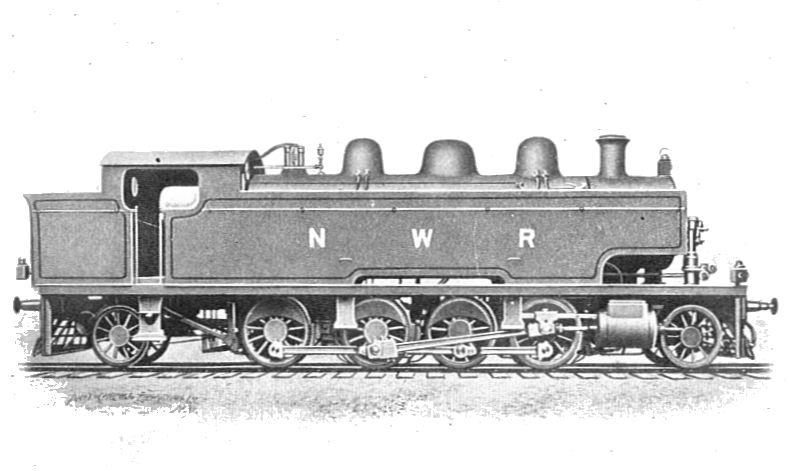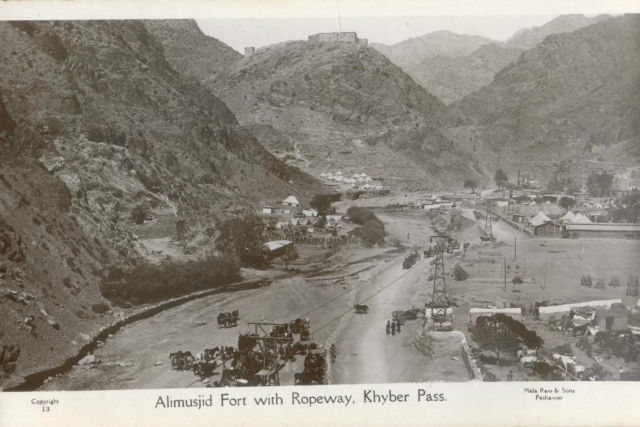Evacuating Kabul by air in 1929, described at Historic Wings.
History
Tramway near Kabul
Another historical Afghan railway to add to the collection! I have found photographic evidence of a narrow gauge tramway in Kabul in 1904.
Trying to identfy places in Kabul
Does anyone know the location of any areas in or near Kabul which a British visitor in around 1900 might have called Chardchi and something like Indeptai/Indeppe/Indebbe (the handwriting is hard to read)?
They were possibly near the Kabul River and/or Asmai Heights (TV Hill) and/or the former workshops and arsenal.
Edmund Rich railway and campaign archive for sale
If anyone has US$25,000 to spare, there is this for sale at The Wayfarer’s Bookshop in Canada:
Unique Extensive & Historically Important Photograph and Document Archive of Edmund Rich, Summarizing his Service as the Official Surveyor of the British Colonial Forces in the North-West Frontier in 1905-1909, and Containing Excellent First-Hand Accounts of the Bazar Valley and Mohmand Campaigns of 1908, as well as a Detailed Survey of the Khyber Pass for the Planned Kabul River Railway and of the District between Malakand, Swat River and Dir.
It includes “several interesting photos of the working survey team under Rich’s command” and of a “railway camp on the Kabul River, 3 miles from Warsak”.
Another similar – or is it the same? – archive collection was sold in December 2012.
Having recently spent a bit of time in various archive collections (sadly I don’t have US$25k to see this one!) I’m currently writing up some notes to update the webpage about the Kabul River Railway scheme. More information has come to light since the page was first written, and while this has answered a number of questions, it has also raised others. Watch this space!
King Amanullah in Manchester
Among Royal visitors received at the works … King Amanullah of Afghanistan in 1928, when to the particular disappointment of the work-girls with their machines decorated in Afghan colours his beautiful Queen Souriya was kept away by indisposition.Source: Metropolitan-Vickers Electrical Co 1899-1949. John Dummelow, Grace’s Guide.
On 28 March 1928 King Amanullah was in Manchester. As well as visiting Metropolitan-Vickers, he sailed on the Manchester ship canal, had lunch with the Mayor, visited two cotton mills and went down the Bradford Colliery Co’s Bradford pit.1
King Amanullah (holding lamp) and a narrow gauge railway at the Bradford colliery.
- Afghan King At Manchester, The Times, London, England, 29 March 1928 ↩
Khyber Ropeway at Ali Masjid
I recently acquired a postcard entitled “Alimusjid Fort with Ropeway, Khyber Pass”, published by Mela Ram & Sons of Peshawar in the 1920s.
This aerial ropeway carried freight from the railhead at Jamrud to British military posts in the Khyber Pass during the period between the Third Afghan War and the opening of the Khyber railway.
The ropeway’s history has been somewhat ignored in comparison to the railway. I have been (very slowly) doing some research at various libraries, and am putting together an article which should appear on this website in due course.
If anyone knows anything about the ropeway or the Khyber Ropeway Company (the army unit which operated it) then do please get in touch. I guess it is pretty much beyond living memory now, but someone might have heard some stories, read their grandfather’s diary or have found some old photos of it tucked away.
(Also, do ropeway historical societies/publications/enthusiasts exist?)
Torghundi railway opening date
The short rail link from Serhertabat in Turkmenistan to Torghundi in Afghanistan has a much lower profile than the railway from Uzbekistan, presumably because of its back-of-beyond location and the general inaccessibility of Turkmenistan.
But it would appear that this was the first main line railway into Afghanistan. So when did it open? Presumably news from a remote border of the Soviet Union wasn’t plentiful at the time it did open, and modern mentions of the railway take a vague guess at little more the Soviet era, but can it be pinned down more accurately?
It certainly predates the Friendship Bridge line from Uzbekistan:
A provincial Soviet newspaper reported in November that work was under way on the “seventh span” of a road-and-rail bridge between the Soviet and Afghan banks of the Amu Darya. “It is planned to open traffic on the new bridge in May 1982,” the report said.
[…]
The railway station at Towraghondi, on Afghanistan’s northwest border with the Soviet Union, is being rebuilt with Soviet help.
Source: Soviets’ second front in Afghanistan, Ned Temko, Staff correspondent of The Christian Science Monitor 4 December 1981
It seems the railway appears in a Russian Central Studio of Documentary Films production about Soviet assistance to Afghanistan, “Over the Highest Mountains” (Выше самых высоких гор). The Net Film webpage says the film is from 1960, but it includes “Khrushchev’s stay in Afghanistan (March, 1961.)”, so something isn’t quite right.
UPDATE: Khrushchev’s visit was in March 1960, his first visit to Afghanistan since 1955.1
This is a section of the English description, with the Russian words interspersed where the translation is a bit odd:
Reel 2
DescriptionPrime Minister of Afghanistan – Mohammed Daoud Khan has arrived in Turgundi station [станцию] to meet one of the first waggonages [составов, Google Translate of the Russian text says “trains”] which has arrived from the USSR.
A waggonage with vehicles, machines, road machinery is moving along a new railway road.
The road machinery designated for construction of Kushka-Terat-Kandahar highway, is being reloaded from platforms [платформ – flat wagon] to lorries.
A panorama of the reloading station – Turgundi.
Source: Over the Highest Mountains, Net Film
UPDATE: The text seems to have changed since I drafted the above post, and now says:
Delivery of goods from the Soviet Union in Afghanistan, a new overland – by rail, going across the border to the border of the village Turgundi – the general plan.
Part of the railway – the average plan.
Composition is the engineer Ivanov.
Trains with goods in transit.
Source: Over the Highest Mountains, Net Film
Mohammed Daoud Khan was Prime Minister from 7 September 1953 to 10 March 1963, which suggests the railway opened at some point 1953-1960.
Транспортная блокада Афганистана is a Russian language article dated 20 May 2011, which says (thanks to Google Translate and a bit of guesswork) that the line was “built to facilitate the delivery of equipment and materials in the construction of highways Kushka – Herat – Kandahar”.
So if we can work out when the road works were undertaken, we might be able to pin down a date for the railway.
- Russians in Afghanistan, The Guardian, 3 March 1960, p10 ↩
King Amanullah on the Southern Railway
Silent film from 1928.
Our Royal Guests – Britain welcomes Amanullah, King of Afghanistan and Souriya, his beautiful Queen
Dover, Kent and London.
[…]
The King and Queen walk beside a train on a railway platform at Dover with their entourage and are greeted by men in white wigs; one reads to them from a book – presumably some kind of traditional greeting; the book is handed to the King, the Queen is given a bunch of flowers.
At a London railway station (probably Victoria) we see the royal party getting off the train and being greeted by King George V and Queen Mary; they are all seen shaking hands with various military dignitaries. The two Kings walk past a line of guards in busbys outside the station then get into an open carriage under a canopy of international flags outside the station; the two Queens can be made out in the background getting into their open carriage.
[…]
Edmund Rich’s Kabul River Railway archive
Bonhams auction 19952 on 4 December 2012 included this lot 283, which sold for £3750.
283 RICH (EDMUND TILLOTSON)
A very good archive representing the military career of Edmund Rich (1874-1937), an officer of the Royal Engineers and surveyor, mostly on the North-West Frontier and in Burma (at first in conjunction with the Survey of India and latterly as one of its directors), also relating to survey in South Persia during World War I, and with the British forces in Southern Russia in 1919, comprising a series of photographs albums, loose photographs, autograph letters, orders, draft reports, maps ephemera, etc., together with a small quantity of photographs, letters and documents relating to Rich’s ancestors, those of his wife Aileen Owen (d.1918), and their son (quantity)
[…]
In 1905 Rich was sent to Peshawar in charge of No. 12 Party with orders to survey the sensitive area north of Kohat Pass. This work lasted four years and included the Bazar Valley and Mohmand campaigns of 1908. The archive contains Rich’s alternative survey for the Kabul River Railway which resulted in the cancellation of the line then under construction, and the dismantling of track and bridges already in place. 1909-1911 were spent in England (Rich married in 1910).
[…]
Source: Bonhams
According to the auction listing, the most substantial of the items include “An album containing titled in manuscript ‘Views of the Khyber Pass…taken chiefly by E.T. Rich when surveying there 1905-1909, approximately 176 gelatin silver prints”.
From this it can be inferred that photos of the Kabul River Railway might well exist.
If you bought this archive, and you happen to read this webpage, is there any chance that I could have a look at it, please? :-)
(a different Edmund Rich was Archbishop of Canterbury in the 13th century, which complicates web searches for any information about this particular one)
Bolan Pass locomotives
Some pictures off t’interwebs.

2-8-2 tank locomotive for the Bolan Pass, North Western Railway of India, from the Boys’ Book of Locomotives by JR Howden, 1907. (Wikimedia Commons, public domain).
Details and picture of a GA/S Class 2-6-2+2-6-2 Garratt.
More on Bolan Pass steam operations.

